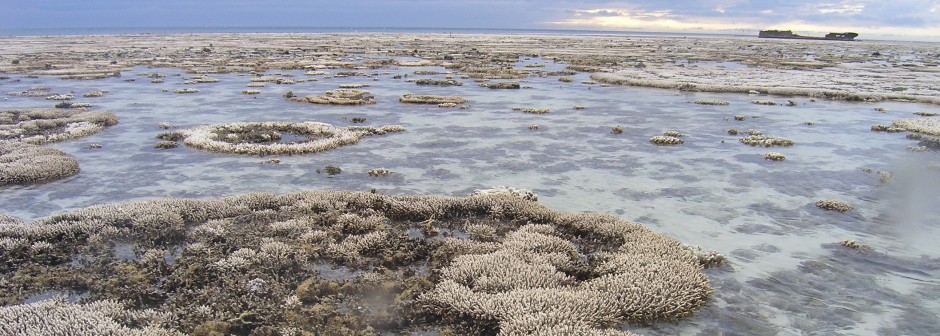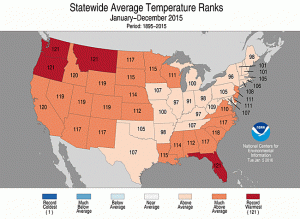If you live in the United States, you may have noticed that 2015 was a hotter, rainier year than usual. If so, then you were certainly on to something; temperature and precipitation levels in 2015 were significantly above historical averages for much of the contiguous states (Figure 1). In fact, it was the second-hottest year ever for the US, and one of the highest globally since data started being collected in 18951. While human-induced climate change clearly has been a major cause of recent temperature increases around the world, there’s another culprit behind 2015’s particular extremity: El Niño.
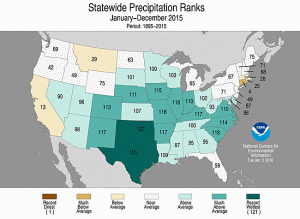
Figure 1: 2015 Temperature (Top) and Precipitation (Below) Rankings for the Contiguous US – States are labelled with a number from 1-121, corresponding to their rank among past 121 years (1895-2015) at that location
Source: https://www.ncdc.noaa.gov/sotc/national/201513 (Reference 1)
El Niño is the warm phase of a sea surface temperature and climate pattern in the Pacific, called the El Niño-Southern Oscillation2 (ENSO), that takes place every 2-7 years; the cool phase that follows is called La Niña. In late 2014 and early 2015, warm water began to rise near the equator, and a wave of heavy rainfall hit the western coast of the Americas, characteristic of the beginning of the El Niño phase (Figure 2). The drastic elevation of sea surface temperatures across the Pacific Ocean that resulted quickly became cause for major global concern.
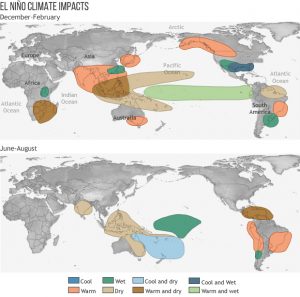
Figure 2: El Niño Global Climate Impacts, First Year – Colors represent different climate conditions; see legend above
Source: https://www.climate.gov/news-features/featured-images/global-impacts-el-ni%C3%B1o-and-la-ni%C3%B1a (Reference 2)
Because Indonesia, Australia and numerous Pacific islands are home to some of the world’s largest and most diverse coral reefs, the severity of this El Niño event was a particularly troubling development for these areas. Many coastal fishing economies in this region rely on the presence and health of reefs, which are extremely diverse marine ecosystems that harbor large fish populations3.
When sea surface temperatures rise too high, reefs can become blanketed in white and experience widespread mortality through a process called coral bleaching. According to the National Oceanic and Atmospheric Administration (NOAA), coral bleaching occurs when the coral organism is “stressed by conditions such as temperature,” expelling the algae responsible for their coloration and inhibiting essential feeding processes4.
Historically, strong El Niños have resulted in some of the worst coral bleaching events on record. For instance, in 1998, statistically one of the strongest ENSO cycles ever, a staggering 16% of coral reefs worldwide perished5. Scientists with the NOAA declared this the first “global bleaching event,” on account of its widespread impact and reef mortality rates3. It mainly affected tracts of reef in Southeast Asia, and during the La Niña phase of 1999, the South Pacific.
The global bleaching event ran its course, and transitioned into 10-12 years of uninterrupted (by ENSO) coral recovery. By the time the less (but still) severe 2010 El Niño began, many bleached, more rapid-growing corals in the Pacific had had an opportunity to regrow3, which somewhat lessened the impact of this “second” global bleaching event. However, when a mere four years later, the 2014-15 El Niño came into effect with nearly unprecedented global air and sea surface temperature increases, the Pacific coral reefs were not even close to sufficiently recovered. Today, in 2017, this “third” event has not yet fully ended, making it one of the most impactful, and the single longest-lasting mass bleaching event in modern history3.
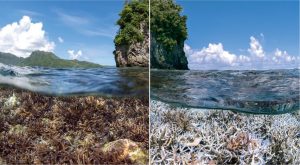
Figure 3: Side-by-Side of December 2014 (left) and February 2015 (right) shows devastating effects of the current (third) mass bleaching event on reefs near American Samoa in the Pacific
Source: http://science.sciencemag.org/content/352/6281/15.full (Reference 5)
A 2016 Science article by Dennis Normile details the severity of the current, third global bleaching event, and warns of the threat climate change and El Niño-driven ocean warming pose to the long-term survival of coral reefs. As early as February 2015, coral reef off the coast of American Samoa had already shown significant signs of bleaching (Figure 3), and by April, over half of corals in parts of Indian Ocean reefs were bleached to some extent5; spring 2016 surveys of Australia’s Great Barrier Reef similarly revealed extensive strands of bleaching and mortality. Normile asserts that “it is not clear what percentage of the bleached coral will die5,” but if the observations accumulated following the record-breaking heat of 2015 are any indication, the global prospects of coral reef survival percentages through the current ENSO (2014-17) are rather grim.
That being said, understanding the strength and frequency of ENSO events is essential for predicting when, and for how long global coral bleaching events will occur in the years to come. Especially as coral restoration efforts continue to progress, we need to know more about the duration of ENSO, in order to best structure the timeline of these processes and ensure the survival of coral reefs for future generations.
References:
1 “National Overview for Annual 2015.” NOAA National Centers for Environmental Information – State of the Climate, pub. online January 2016. Web. 20 Feb. 2017. http://www.ncdc.noaa.gov/sotc/national/201513
2 Lindsey, Rebecca. “Global impacts of El Niño and La Niña.” Climate.gov – NOAA, pub. online 9 Feb. 2016. Web. 20 Feb. 2017. https://www.climate.gov/news-features/featured-images/global-impacts-el-ni%C3%B1o-and-la-ni%C3%B1a
3 “El Niño prolongs longest global coral bleaching event.” News and Features – NOAA, pub. online 23 Feb. 2016. Web. 20 Feb 2017. http://www.noaa.gov/media-release/el-ni-o-prolongs-longest-global-coral-bleaching-event
4 “What is coral bleaching?” What is coral bleaching? – Ocean Facts. National Ocean Service – U.S. NOAA, n.d. Web. 20 Feb. 2017. http://oceanservice.noaa.gov/facts/coral_bleach.html
5 Normile, Dennis. “El Niño’s warmth devastating reefs worldwide.” Science, 01 Apr 2016. Vol. 352, Issue 6281, pp. 15-16. Accessed online, 19 Feb. 2017. http://science.sciencemag.org/content/352/6281/15.full

